The
Home Page Selection
If
you require further information on any
print featured here, please contact
us.
When
a print has been sold it will be marked
as Sold.
A
growing archive of selections
from previous Home pages is featured in
the
Home
Page Selection Archive |
|
See
also :
Click
on a thumbnail (left)
to link directly with the entry for that
print, or scroll down to view all the selected
prints from the current Home
Page.
Images
are not to relative scale (see stated dimensions) and also at only modest resolution.
If you wish to view extracts of an image at higher resolution, please Contact us.
|
|
|
|
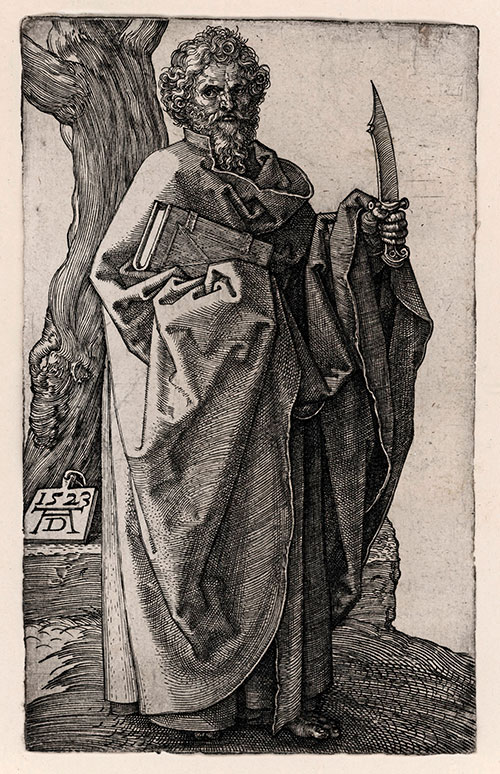
| |
ALBRECHT DŰRER
Nuremberg 1471 – 1528 Nuremberg
Dürer returned home in 1521 from his extended trip to the Netherlands suffering from malaria.
In his last years he engraved three of the Apostles and a number of portraits, including some of the leading thinkers of the day. He also published his book on measurements and prepared that on proportions.
Erasmus published a tribute to Dürer in 1528, shortly before the artist’s death, comparing him to the great ancient Greek painter Apelles, who was aided by the use of colour.
What does he [Dürer] not express in monochromes, that is in black lines?
Shade, light, radiance, projections, depressions …
He even depicts what cannot be depicted: fire, rays of light, thunderstorms, sheet
lightning, thunderbolts…
the whole mind of man as it shines forth…
These things he places before our eyes by the most felicitous lines, black ones at that,
in such a manner that, were you to spread pigments, you would injure the work.
St Bartholomew
Illustrated Bartsch 47 a/d
121 x 75 mm
Original engraving, 1523.
The plate signed with the monogram on a tablet and dated.
Trimmed to the plate.
On unwatermarked laid paper.
A skinned patch verso.
Sold
The New Testament mentions only Bartholomew’s name, none of his acts.
It was Jacobus de Varagine, in The Golden Legend, c1260, who related a missionary journey to India and Bartholomew’s death in Armenia by being flayed alive.
Bartholomew holds the knife which would have been used for his martyrdom.
Dürer made the first two of a projected but unfinished series of the twelve Apostles in 1514, Thomas and Paul, both with halos; he returned to the theme in 1523, when he engraved Bartholomew and Simon, adding Philip in 1526, all without halos.
Return to top ^ |
|
|
|
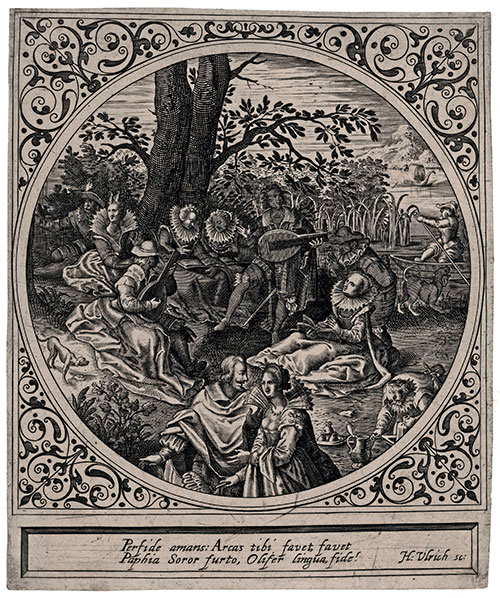
|
|
HEINRICH ULRICH
Active in Nuremberg from c1595 – 1621
Ulrich was an engraver and publisher.
He moved to Vienna in 1613, probably to avoid his debts.
He was usually a reproductive engraver.
Pastoral Concert
178 x 148 mm
Engraving, c1600.
On laid paper without watermark.
Trimmed to or just into the plate.
Sold
Return to top ^ |
|
|
|
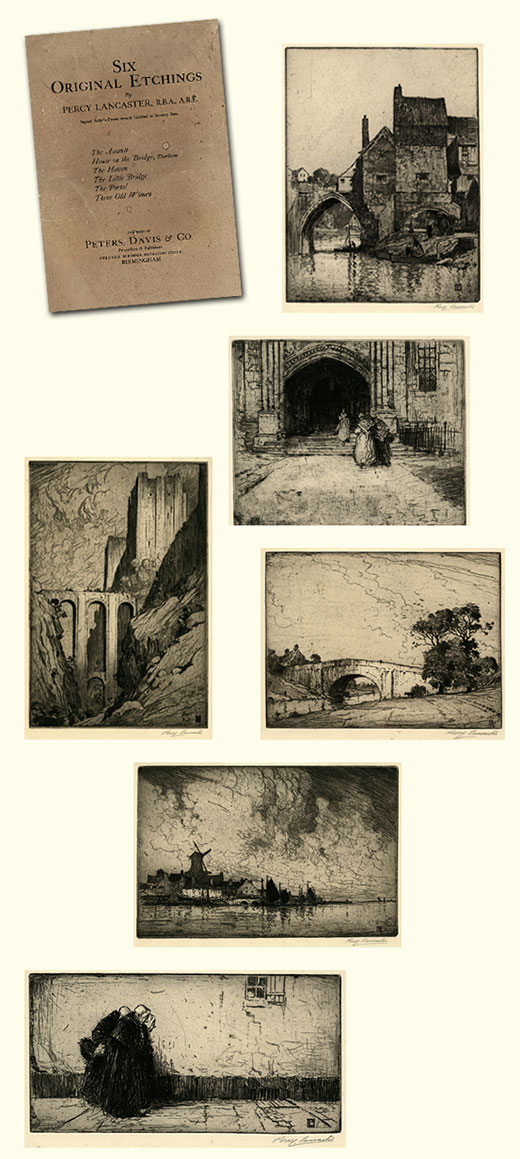 |
|
PERCY LANCASTER A.R.E.
Manchester 1878 – 1950 Stockport
Lancaster initially trained as an architect, but turned to painting in oils and watercolours,
studying at Stockport School of Art.
He exhibited widely but principally with the two societies of which he was a member,
the Royal Society of British Artists and the R.E., to which he had been elected in 1912.
Six Original Etchings
530 x 365 mm (mount size) plates of various sizes
The complete set, with the original title page (defective) and individual labels, published by Peters, Davis & Co, Birmingham.
Each etching monogrammed in the plate and signed in pencil.
Each embossed in the margin with the publishers’ blindstamp.
One dated in the plate (The Little Bridge), but unclearly.
Edition of 70.
£750
Comprising
- The Assault
- House on the Bridge, Durham
- The Haven
- The Little Bridge
- The Portal
- Three Old Women
Return
to top ^ |
|
|
|
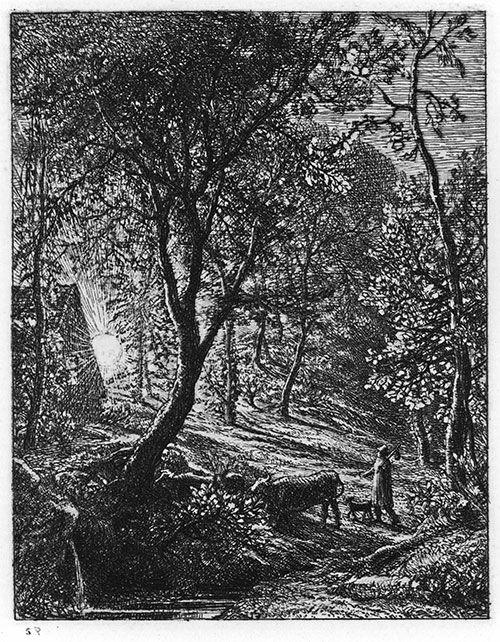 |
|
SAMUEL PALMER
Newington, south London 1805 – 1881 Redhill, near Reigate, Surrey
The Herdsman’s Cottage
Alexander 3 ii/ii, Lister 3 ii/ii
124 x 100 mm (bevelled plate)
98 x 76 mm (image)
430 x 300 mm (sheet)
Etching, 1850.
The plate initialled in the lower border.
Published state, issued by P G Hamerton 1872-80.
On laid paper.
Sold
The plate was not published till 1872, when Hamerton included it in The Portfolio.
This impression is from Hamerton’s Examples of Modern Etching, 1875.
Hamerton would issue it a third time in the 1880 edition of Etching and Etchers,
reflecting his admiration for the plate which he considered
“in its own way, … is like a pearl or diamond without flaw”.
Although no specific poetry is known to be directly related to the subject, Edward Twohig has noticed a very similar sentiment in Milton’s Paradise Lost (Book 2, 500-)
If chance the radiant sun with farewell sweet
Extend his evening beam, the fields revive,
The birds their notes renew and bleating herds
Attest their joy, that hill and valley rings.
Return
to top ^ |
|
|
|
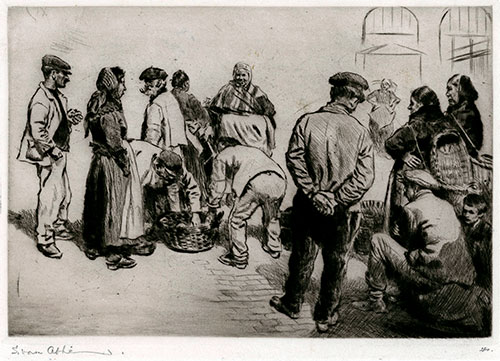 |
|
SALOMON VAN ABBE
Amsterdam 1883 – 1955 London
The son of a diamond merchant, van Abbé moved to London
with his family as a child.
He trained among other places, at the Central and in engraving at Bolt Court,
where from about 1912 he was the fellow student of Blampied
who married van Abbé’s sister Marianne in 1914.
The brothers-in-law shared a sympathetic eye for character and a sense of humour.
Van Abbé worked as an illustrator and designer of book covers.
Because of the War his etching career only properly began in the 1920’s.
He was elected an Associate of the R.E. in 1923.
Dieppe Fisherfolk
180 x 261 mm
Original drypoint, c1925.
Signed in pencil and numbered 2/60.
On cream wove.
£300
Return
to top ^ |
|
|
|
|
|
|
|